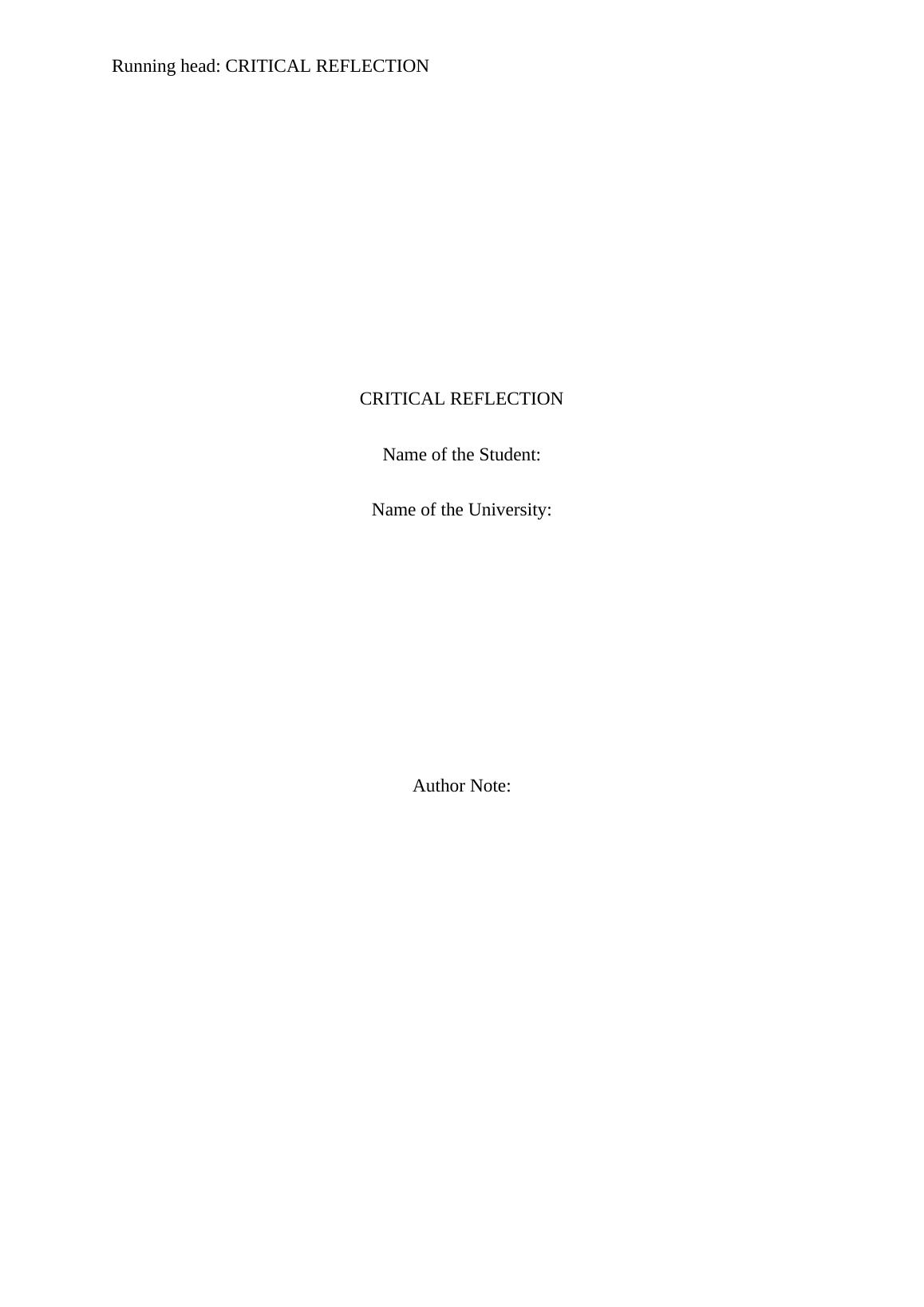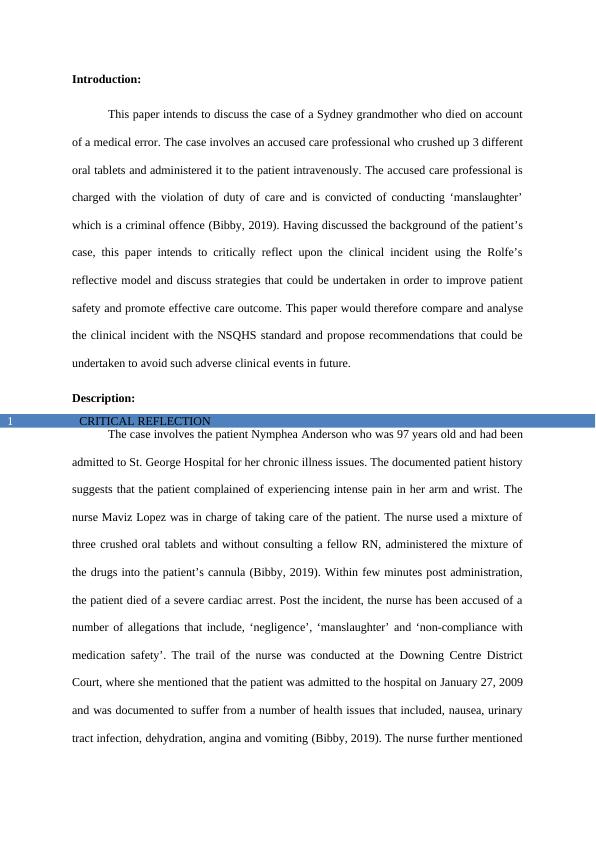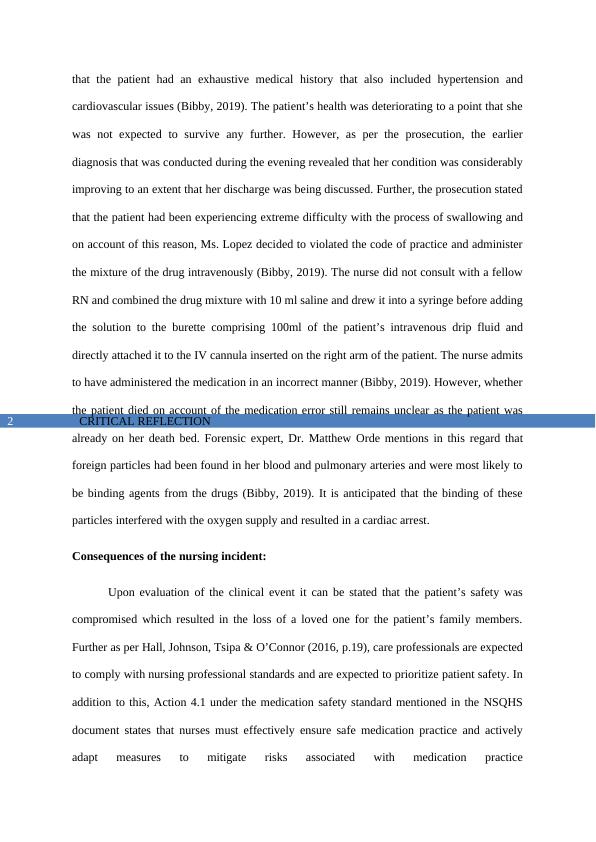Critical Reflection on Medication Error Leading to Patient Death
Added on 2022-10-04
7 Pages1690 Words395 Views
Running head: CRITICAL REFLECTION
CRITICAL REFLECTION
Name of the Student:
Name of the University:
Author Note:
CRITICAL REFLECTION
Name of the Student:
Name of the University:
Author Note:

CRITICAL REFLECTION1
Introduction:
This paper intends to discuss the case of a Sydney grandmother who died on account
of a medical error. The case involves an accused care professional who crushed up 3 different
oral tablets and administered it to the patient intravenously. The accused care professional is
charged with the violation of duty of care and is convicted of conducting ‘manslaughter’
which is a criminal offence (Bibby, 2019). Having discussed the background of the patient’s
case, this paper intends to critically reflect upon the clinical incident using the Rolfe’s
reflective model and discuss strategies that could be undertaken in order to improve patient
safety and promote effective care outcome. This paper would therefore compare and analyse
the clinical incident with the NSQHS standard and propose recommendations that could be
undertaken to avoid such adverse clinical events in future.
Description:
The case involves the patient Nymphea Anderson who was 97 years old and had been
admitted to St. George Hospital for her chronic illness issues. The documented patient history
suggests that the patient complained of experiencing intense pain in her arm and wrist. The
nurse Maviz Lopez was in charge of taking care of the patient. The nurse used a mixture of
three crushed oral tablets and without consulting a fellow RN, administered the mixture of
the drugs into the patient’s cannula (Bibby, 2019). Within few minutes post administration,
the patient died of a severe cardiac arrest. Post the incident, the nurse has been accused of a
number of allegations that include, ‘negligence’, ‘manslaughter’ and ‘non-compliance with
medication safety’. The trail of the nurse was conducted at the Downing Centre District
Court, where she mentioned that the patient was admitted to the hospital on January 27, 2009
and was documented to suffer from a number of health issues that included, nausea, urinary
tract infection, dehydration, angina and vomiting (Bibby, 2019). The nurse further mentioned
Introduction:
This paper intends to discuss the case of a Sydney grandmother who died on account
of a medical error. The case involves an accused care professional who crushed up 3 different
oral tablets and administered it to the patient intravenously. The accused care professional is
charged with the violation of duty of care and is convicted of conducting ‘manslaughter’
which is a criminal offence (Bibby, 2019). Having discussed the background of the patient’s
case, this paper intends to critically reflect upon the clinical incident using the Rolfe’s
reflective model and discuss strategies that could be undertaken in order to improve patient
safety and promote effective care outcome. This paper would therefore compare and analyse
the clinical incident with the NSQHS standard and propose recommendations that could be
undertaken to avoid such adverse clinical events in future.
Description:
The case involves the patient Nymphea Anderson who was 97 years old and had been
admitted to St. George Hospital for her chronic illness issues. The documented patient history
suggests that the patient complained of experiencing intense pain in her arm and wrist. The
nurse Maviz Lopez was in charge of taking care of the patient. The nurse used a mixture of
three crushed oral tablets and without consulting a fellow RN, administered the mixture of
the drugs into the patient’s cannula (Bibby, 2019). Within few minutes post administration,
the patient died of a severe cardiac arrest. Post the incident, the nurse has been accused of a
number of allegations that include, ‘negligence’, ‘manslaughter’ and ‘non-compliance with
medication safety’. The trail of the nurse was conducted at the Downing Centre District
Court, where she mentioned that the patient was admitted to the hospital on January 27, 2009
and was documented to suffer from a number of health issues that included, nausea, urinary
tract infection, dehydration, angina and vomiting (Bibby, 2019). The nurse further mentioned

CRITICAL REFLECTION2
that the patient had an exhaustive medical history that also included hypertension and
cardiovascular issues (Bibby, 2019). The patient’s health was deteriorating to a point that she
was not expected to survive any further. However, as per the prosecution, the earlier
diagnosis that was conducted during the evening revealed that her condition was considerably
improving to an extent that her discharge was being discussed. Further, the prosecution stated
that the patient had been experiencing extreme difficulty with the process of swallowing and
on account of this reason, Ms. Lopez decided to violated the code of practice and administer
the mixture of the drug intravenously (Bibby, 2019). The nurse did not consult with a fellow
RN and combined the drug mixture with 10 ml saline and drew it into a syringe before adding
the solution to the burette comprising 100ml of the patient’s intravenous drip fluid and
directly attached it to the IV cannula inserted on the right arm of the patient. The nurse admits
to have administered the medication in an incorrect manner (Bibby, 2019). However, whether
the patient died on account of the medication error still remains unclear as the patient was
already on her death bed. Forensic expert, Dr. Matthew Orde mentions in this regard that
foreign particles had been found in her blood and pulmonary arteries and were most likely to
be binding agents from the drugs (Bibby, 2019). It is anticipated that the binding of these
particles interfered with the oxygen supply and resulted in a cardiac arrest.
Consequences of the nursing incident:
Upon evaluation of the clinical event it can be stated that the patient’s safety was
compromised which resulted in the loss of a loved one for the patient’s family members.
Further as per Hall, Johnson, Tsipa & O’Connor (2016, p.19), care professionals are expected
to comply with nursing professional standards and are expected to prioritize patient safety. In
addition to this, Action 4.1 under the medication safety standard mentioned in the NSQHS
document states that nurses must effectively ensure safe medication practice and actively
adapt measures to mitigate risks associated with medication practice
that the patient had an exhaustive medical history that also included hypertension and
cardiovascular issues (Bibby, 2019). The patient’s health was deteriorating to a point that she
was not expected to survive any further. However, as per the prosecution, the earlier
diagnosis that was conducted during the evening revealed that her condition was considerably
improving to an extent that her discharge was being discussed. Further, the prosecution stated
that the patient had been experiencing extreme difficulty with the process of swallowing and
on account of this reason, Ms. Lopez decided to violated the code of practice and administer
the mixture of the drug intravenously (Bibby, 2019). The nurse did not consult with a fellow
RN and combined the drug mixture with 10 ml saline and drew it into a syringe before adding
the solution to the burette comprising 100ml of the patient’s intravenous drip fluid and
directly attached it to the IV cannula inserted on the right arm of the patient. The nurse admits
to have administered the medication in an incorrect manner (Bibby, 2019). However, whether
the patient died on account of the medication error still remains unclear as the patient was
already on her death bed. Forensic expert, Dr. Matthew Orde mentions in this regard that
foreign particles had been found in her blood and pulmonary arteries and were most likely to
be binding agents from the drugs (Bibby, 2019). It is anticipated that the binding of these
particles interfered with the oxygen supply and resulted in a cardiac arrest.
Consequences of the nursing incident:
Upon evaluation of the clinical event it can be stated that the patient’s safety was
compromised which resulted in the loss of a loved one for the patient’s family members.
Further as per Hall, Johnson, Tsipa & O’Connor (2016, p.19), care professionals are expected
to comply with nursing professional standards and are expected to prioritize patient safety. In
addition to this, Action 4.1 under the medication safety standard mentioned in the NSQHS
document states that nurses must effectively ensure safe medication practice and actively
adapt measures to mitigate risks associated with medication practice

End of preview
Want to access all the pages? Upload your documents or become a member.
Related Documents
NURSING REFLECTION Assignmentlg...
|7
|1695
|13
Nursing Negligence Death of the Patient Australia Case Study 2022lg...
|7
|1509
|38
Assignment On Approaches | Reportlg...
|7
|1589
|23
Case Study Discussion 2022lg...
|7
|1335
|12
Approaches To Professional Nursing Practicelg...
|9
|1773
|21
Professional Nursing Practice Assignmentlg...
|6
|1520
|29
